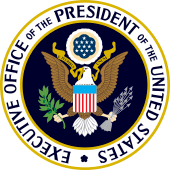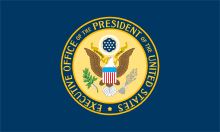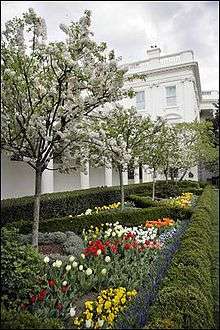Executive Office of the President of the United States
 Seal of the Executive Office of the President | |
 Flag of the Executive Office of the President | |
| Agency overview | |
|---|---|
| Formed | July 1, 1939 |
| Headquarters | White House |
| Employees | 4,000 (approximately) |
| Annual budget | $300–400 million |
| Agency executive | |
| Parent agency | United States federal government |
| Website | Executive Office of the President |
The Executive Office of the President of the United States (EOP) is a group of agencies[1] at the center of the executive branch of the United States federal government. The EOP supports the work of the President. It consists of several offices and agencies, such as the White House Office (the staff working directly for and reporting to the President, including West Wing staff and the President’s closest advisers), National Security Council or Office of Management and Budget.
With the increase in technological and global advancement, the size of the White House staff has increased to include an array of policy experts to effectively address various fields of the modern day.
The Executive Office is overseen by the White House Chief of Staff, currently John F. Kelly, as appointed by the current and 45th President of the United States.[2]
History
In 1939, during Franklin D. Roosevelt's second term in office, the foundations of the modern White House staff were created. Based on the recommendations of a presidentially commissioned panel of political science and public administration experts that was known as the Brownlow Committee, Roosevelt was able to get Congress to approve the Reorganization Act of 1939. The Act led to Reorganization Plan No. 1,[3] which created the EOP,[4] which reported directly to the president. The EOP encompassed two subunits at its outset: the White House Office (WHO) and the Bureau of the Budget, the predecessor to today's Office of Management and Budget, which had been created in 1921 and originally located in the Treasury Department. It absorbed most of the functions of the National Emergency Council.[5] Initially, the new staff system appeared more ambitious on paper than in practice; the increase in the size of the staff was quite modest at the start. But it laid the groundwork for the large and organizationally complex White House staff that would emerge during the presidencies of Roosevelt's successors.[6]
Roosevelt's efforts are also notable in contrast to those of his predecessors in office. During the nineteenth century, presidents had few staff resources. Thomas Jefferson had one messenger and one secretary at his disposal, both of whose salaries were paid by the president personally. It was not until 1857 that Congress appropriated money ($2,500) for the hiring of one clerk. By Ulysses S. Grant's presidency (1869–1877), the staff had grown to three. By 1900, the White House staff included one "secretary to the president" (then the title of the president's chief aide), two assistant secretaries, two executive clerks, a stenographer, and seven other office personnel. Under Warren G. Harding, the size of the staff expanded to thirty-one, although most were clerical positions. During Herbert Hoover's presidency, two additional secretaries to the president were added by Congress, one of whom Hoover designated as his Press Secretary. From 1933 to 1939, even as he greatly expanded the scope of the federal government's policies and powers in response to the Great Depression, Roosevelt muddled through: his "brains trust" of top advisers were often appointed to vacant positions in agencies and departments, whence they drew their salaries since the White House lacked statutory or budgetary authority to create new staff positions.
After World War II, in particular during the presidency of Dwight David Eisenhower, the staff was expanded and reorganized. Eisenhower, a former U.S. Army general, had been Supreme Allied Commander during the war, and brought ideas of effective organization from that experience.[7]
Today, the staff is much bigger. Estimates indicate some 3,000 to 4,000 persons serve in EOP staff positions with policy-making responsibilities, with a budget of $300 to $400 million (George W. Bush's budget request for Fiscal Year 2005 was for $341 million in support of 1,850 personnel).[8]
Organization
Senior staff within the Executive Office of the President have the title Assistant to the President, second-level staff have the title Deputy Assistant to the President, and third-level staff have the title Special Assistant to the President.
The core White House staff appointments, and most EOP officials generally, are not required to be confirmed by the U.S. Senate, although there are a handful of exceptions (e.g., the Director of the Office of Management and Budget, the Chair and members of the Council of Economic Advisers, and the United States Trade Representative).
The information in the following table is current as of April 4, 2018. Only principal executives are listed; for subordinate officers, see individual office pages.
White House Offices
The White House Office (including its various offices listed below) is a sub-unit of the Executive Office of the President (EOP). The various agencies of the EOP are listed above.
- Office of the Chief of Staff
- Office of the National Security Advisor
- Domestic Policy Council
- National Economic Council
- Office of American Innovation
- Office of Cabinet Affairs
- Office of Communications
- Office of Information Technology
- Office of Digital Strategy
- Office of the First Lady
- Office of Intergovernmental Affairs
- Office of Legislative Affairs
- Office of Management and Administration
- Office of Political Affairs
- Office of Presidential Personnel
- Office of Public Liaison
- Office of Scheduling and Advance
- Office of the Staff Secretary
- Oval Office Operations
- White House Counsel
- White House Presidential Personnel Office
Budget history
| Year | Budget |
|---|---|
| 2017 | $587 million[10] |
| 2016 | $692 million[11] |
| 2015 | $676 million[12] |
| 2014 | $624 million[13] |
| 2013 | $650 million[14] |
| 2012 | $640 million[15] |
| 2011 | $708 million[16] |
| 2010 | $772 million[17] |
| 2009 | $728 million[18] |
| 2008 | $682 million[19] |
| 2007 | $need cite million[20] |
| 2006 | $need cite million[20] |
| 2005 | $need cite million[20] |
| 2004 | $need cite million[20] |
| 2003 | $386 million[20] |
| 2002 | $451 million[20] |
| 2001 | $246 million[20] |
| 2000 | $283 million[20] |
| 1999 | $417 million[20] |
| 1998 | $237 million[20] |
| 1997 | $221 million[20] |
| 1996 | $202 million[20] |
| 1995 | $215 million[20] |
| 1994 | $231 million[20] |
| 1993 | $194 million[20] |
See also
References
- ↑ Harold C. Relyea (26 November 2008). The Executive Office of the President: A Historical Overview (PDF) (Report). Washington, D.C.: Congressional Research Service. Retrieved 17 April 2018.
- ↑ Hartnett, Cass (November 6, 2017). "Library Guides: United States Federal Government Resources: The Executive Office of the President". guides.lib.uw.edu. Retrieved 2017-11-09.
- ↑ Roosevelt, Franklin D. (April 25, 1939). "Message to Congress on the Reorganization Act". John T. Woolley and Gerhard Peters. The American Presidency Project. Santa Barbara: University of California. Retrieved May 6, 2011.
- ↑ Mosher, Frederick C. (1975). American Public Administration: Past, Present, Future (2nd ed.). Birmingham: University of Alabama Press. ISBN 0-8173-4829-8.
- ↑ Roosevelt, Franklin D. (May 9, 1939). "Message to Congress on Plan II to Implement the Reorganization Act". John T. Woolley and Gerhard Peters. The American Presidency Project. Santa Barbara: University of California. Retrieved May 6, 2011.
The plan provides for the abolition of the National Emergency Council and the transfer to the Executive Office of the President of all its functions with the exception of the film and radio activities which go to the Office of Education.
- ↑ Relyea, Harold C. (March 17, 2008). "The Executive Office of the President: An Historical Overview" (PDF). Congressional Research Service. Retrieved April 14, 2008.
- ↑ Patterson, Bradley H. (1994). "Teams and Staff: Dwight Eisenhower's Innovations in the Structure and Operations of the Modern White House". Presidential Studies Quarterly. 24 (2): 277–298. JSTOR 27551241.
- ↑ Burke, John P. "Administration of the White House". Miller Center of Public Affairs, University of Virginia. Archived from the original on November 17, 2010. Retrieved June 6, 2009.
- ↑ Bennett, Kate (June 23, 2017). "Trump family hires familiar face as chief usher". CNN.
- ↑ "FY 2017 Omnibus Summary – Financial Services and General Government Appropriations" (PDF). House Appropriations Committee. May 1, 2017. Retrieved May 1, 2017.
- ↑ "Appropriations Committee Releases Fiscal Year 2016 Financial Services Bill". House Appropriations Committee. May 24, 2016. Retrieved May 1, 2017.
- ↑ "Appropriations Committee Releases Fiscal Year 2015 Financial Services Bill". House Appropriations Committee. July 16, 2014. Retrieved May 1, 2017.
- ↑ "Appropriations Committee Releases Fiscal Year 2014 Financial Services Bill". House Appropriations Committee. July 17, 2013. Retrieved May 1, 2017.
- ↑ "Appropriations Committee Releases Fiscal Year 2013 Financial Services Bill". House Appropriations Committee. June 5, 2012. Retrieved May 1, 2017.
- ↑ "Appropriations Committee Releases Fiscal Year 2012 Financial Services Bill". House Appropriations Committee. June 15, 2011. Retrieved May 1, 2017.
- ↑ "Financial Services and General Government (FSGG): FY2011 Appropriations". Congressional Research Service. July 11, 2011. Retrieved May 1, 2017.
- ↑ "Financial Services and General Government (FSGG): FY2010 Appropriations" (PDF). Congressional Research Service. February 4, 2010. Retrieved May 1, 2017.
- ↑ "Financial Services and General Government (FSGG): FY2009 Appropriations" (PDF). Congressional Research Service. May 12, 2009. Retrieved May 1, 2017.
- ↑ "Financial Services and General Government (FSGG): FY2008 Appropriations". Congressional Research Service. December 20, 2007. Retrieved May 1, 2017.
- 1 2 3 4 5 6 7 8 9 10 11 12 13 14 15 "Historical Tables, Table 4.1—OUTLAYS BY AGENCY: 1962–2022". OFFICE OF MANAGEMENT AND BUDGET. January 20, 2017. Retrieved September 25, 2017.
External links
- Executive Office of the President
- The Debate Over Selected Presidential Assistants and Advisors: Appointment, Accountability, and Congressional Oversight Congressional Research Service
- Proposed and finalized federal regulations from the Executive Office of the President of the United States
- Works by Executive Office of the President of the United States at Project Gutenberg
- Works by or about Executive Office of the President of the United States at Internet Archive


